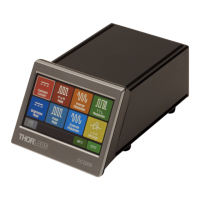© 2020 Thorlabs GmbH
4 Write Your Own Application
41
4.3 Command Reference
4.3.1 IEEE488.2 Common Commands
Common commands are device commands that are common to all devices according to the
IEEE488.2 standard. These commands are designed and defined by this standard. Most of the
commands are described in detail in this section. The following common commands associated
with the status structure are covered in the “Status Structure” section: *CLS, *ESE, *ESE?,
*ESR?, *SRE, *SRE?, *STB?
Command summary
Clears all event registers and Error Queue
Sets the Standard Event Enable Register
Returns the Standard Event Enable Register
Event status register query
Returns and clears the Standard Event Register
Returns the unit’s identification string
Operation complete command
Sets the Operation Complete bit in the Standard Event Re-
gister
Places a “1” into the output queue when all device operations
have been completed
Returns the unit to the *RST default condition
Service request enable command
Sets the Service Request Enable Register
Service request enable query
Returns the Service Request Enable Register
Returns the Status Byte Register
Performs the unit’s self-test and returns the result.
Waits until all previous commands are executed
Command reference
1. *IDN? – identification query - read identification code
The identification code includes the manufacturer, model code, serial number, and firmware re-
vision levels and is sent in the following format: Thorlabs GmbH,MMM,SSS,X.X.X, where
is the instrument firmware revision level
Example: THORLABS,DC2200,M00123456,1.0.1
2. *OPC – operation complete - set OPC bit
3. *OPC? – operation complete query – places a “1” in output queue
When *OPC is sent, the OPC bit in the Standard Event Register will set after all pending com-
mand operations are complete. When *OPC? is sent, an ASCII “1” is placed in the Output
Queue after all pending command operations are complete.
Typically, either one of these commands is sent after the INITiate command. The INITiate
command is used to take the instrument out of idle in order to perform measurements. While
operating within the trigger model layers, many sent commands will not execute. After all pro-
grammed operations are completed, the instrument returns to the idle state at which time all
pending commands (including *OPC and/or *OPC?) are executed. After the last pending com-
mand is executed, the OPC bit and/or an ASCII “1” is placed in the Output Queue.

